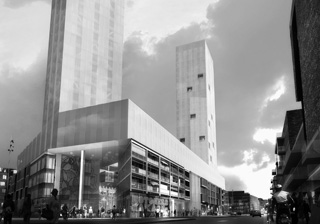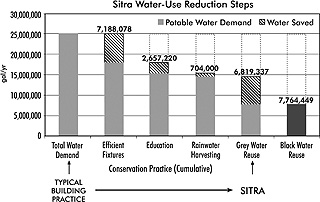
Surveys
DJC.COM
October 22, 2009
European contest spurs new ideas in sustainable design
Magnusson Klemencic Associates

Gangnes
|
A recent international design competition in Finland provided a glimpse into the future of green building design.
The competition — dubbed Low2No and hosted in July by Sitra, the Finnish Innovation Fund — challenged competitors to design a 237,000-square-foot mixed-use facility as a prototype for low- or no-carbon development practices.
One of the five finalist teams, led by REX Architects of New York and comprising several European firms and Magnusson Klemencic Associates, threw convention to the wind and started from this question: “What is the lowest-carbon-use distribution within a building volume, and what is the lowest-carbon way to structure that distribution?” Even further, the team asked: “What is the most climate-change-responsible way to deal with water in the future?”
By turning the design process inside out, the team developed a carbon-optimized structure with a totally integrated water model, and along the way learned numerous lessons in climate-conscious building design.
Carbon, the new kilowatt

Image courtesy of REX Architects The design developed by REX Architects’ team for Sitra’s Low2No competition used a carbon-conscious massing configuration that allowed future low-carbon infill and held retrofit potential for Helsinki’s existing central core.
|
Since the energy crisis of the 1970s, our parents (“Turn off the lights,” “Put on a sweater”) and then the U.S. Green Building Council have educated us in building energy usage issues and served as catalysts for lowering energy consumption. More recently, however, anyone who has heard the expression “carbon footprint” likely has some inkling that carbon is equally important.
Carbon taxes and “cap-and-trade” regulations are under debate in Congress, and initiatives like the Architecture 2030 Challenge, ACUP Climate Commitment, and other efforts are targeting greenhouse gas emissions associated with building and facility operations. It is clear that addressing the carbon embodied in the creation of a building is the next wave in green building design.
The carbon trail
So where to start? A completed building contains thousands of materials, all with complicated supply-chain carbon emissions. A building’s structure, however, is typically made up of just a handful of items — all with clear links to the industries that create them and the transportation that delivers them. Since a typical structure represents approximately 30 percent of total building material costs, it follows that a similar portion of a building’s embodied carbon is addressed when the structure is the focus. Therefore, our team’s goal was to create a carbon-optimized structure with a structural scheme containing the least amount of embodied carbon.
To do this, MKA created a carbon analysis model that identified the carbon used during the manufacture and transportation of concrete, reinforcing steel, structural steel and other materials locally available in Finland. The framing schemes under consideration for the team’s proposal (two high-rise residential towers over a low-rise office loop) were then analyzed using this model to determine their relative embodied carbon.
The results were surprising.
Helinski’s traditional market conditions and construction practices default to concrete for high-rise residential towers. Yet, assuming baseline Helsinki-style construction (typical of many countries around the world), the team found that an intervention as simple as reducing concrete cement content by substituting complementary cementing materials such as fly ash or mill slag reduced the structure’s embodied carbon by 23 percent. Additional concrete replacement practices reduced structural carbon by another 23 percent, for a total reduction of 46 percent without veering from concrete-only construction.
Ultimately, the team achieved another 17 percent reduction by proposing a hybrid structure to mitigate the carbon-intensive floor and lateral systems.

Chart courtesy of MKA Integrated water modeling proved that a project can achieve net-zero water if taken to the level of on-site sewage treatment. The REX team entry stopped at gray water reuse to avoid creation of redundant sewage infrastructure, acknowledging existing long-term capacity in Helsinki’s public system. |
The low-rise office component, also typically concrete in Helsinki, was identified by the team as an opportunity for systemic change: Many offices are made out of steel in the United States, and, as mentioned, steel is assumed to be lower in carbon.
Once again, the results were surprising.
The team’s steel scheme was not initially lower in carbon, something ultimately attributable to Finnish steel being approximately 3.5 times “dirtier” than U.S. steel. When the model was revised to reflect U.S.-level steel emissions, steel was the carbon winner. In the spirit of the competition’s goals, the team proposed steel for the office, with a recommendation for systemic improvements to the Finnish steel industry’s factory emissions.
Water’s importance
Water is as important as greenhouse gas emissions in the climate-change discussion. Water-related public infrastructures are tapped out: Sewage treatment plants are at capacity, and new drinking water sources are harder to come by. The effects of climate change will only make this situation worse, as more frequent flash storms cause more urban flooding and system overflows.
For the last 100 years, civil engineers have dealt with water-related infrastructure in three separate silos: water supply, sewage treatment and stormwater runoff management. This has led to unsustainable infrastructures, as the overlap in these systems has been ignored.
For Sitra, the team pursued an integrated water management system that: Provides a portion of the services traditionally provided by public infrastructure; contributes to repair of the hydrologic cycle; and integrates all water-related infrastructures into a single design pursuit.
Decentralized infrastructure
By modeling the integrated benefits of a number of water-reduction and re-use strategies, such as rainwater harvesting and gray water reuse, the team ultimately reduced the project’s potable water demand by 69 percent over a comparable conventional project.
In addition, the team’s design reduced the project’s sewage output by 65 percent and entirely eliminated rainfall-generated runoff.
These combined strategies reduced the amount of off-site potable water required to just 50 percent of the water needs, with the other 50 percent met by recycled, project-generated water. In particular, for toilet flushing (a very potable-water-wasteful operation) the design relied on potable water for only 5 percent of its annual requirement.
Balancing water use
Setting and achieving water-reduction goals is not new. What this effort taught us, though, is the power that a comprehensive water-balance modeling tool can bring to design decisions when all water-related infrastructures, both in the building and on site, are considered holistically.
The model created by the team provided immediate feedback on optimum configuration. For example, a simple tweak to increase residential square footage revealed an increase in not only potable water demand, but also gray water, as well as an updated report of project-wide water and sewage statistics.
This type of “what if” approach enables a new design process. One can imagine a future where a project’s mixed-use breakdown is driven by balancing water resource supplies and demands of complementary-use types. If the Sitra program had been massed into two standalone, climate-conscious buildings, the total water consumption would have been 40 percent more!
Looking ahead
While Europe is often considered ahead of the U.S. on environmental issues, green building rating programs such as LEED have been the province of the U.S. One could argue that Europe has been focused on the macro (adoption of the Kyoto Protocol capping greenhouse gas emissions), while the U.S. has been focused on the micro (improving environmental conditions one building at a time).
The Finland competition foreshadowed a merging of these two viewpoints, incorporating the strengths of both. As noted by Sitra: “It is clear that no single organization, profession or nation can achieve the goals of sustainable global development.”
As the U.S. joins the world in awareness of climate-change impact, look for climate-conscious green building design as the next big thing.
Drew A. Gangnes, PE, SE, is a principal at Magnusson Klemencic Associates and leader of the firm’s Sustainability Specialist Group.
Other Stories:
- Does your building measure up, energy wise?
- Green Building Council faces critical forest decision
- A welcoming new home for ACRS
- Dutch architects reinvent modular construction
- Architects step up to help developers
- How wayfinding signs can enhance your brand
- Ballard QFC requires unique structural solution
- Knowing when to build and when to remodel
- Skyrocket your chances of winning contracts
- Can the Toyota design approach help make great places?
Copyright ©2009 Seattle Daily Journal and DJC.COM.
Comments? Questions? Contact us.